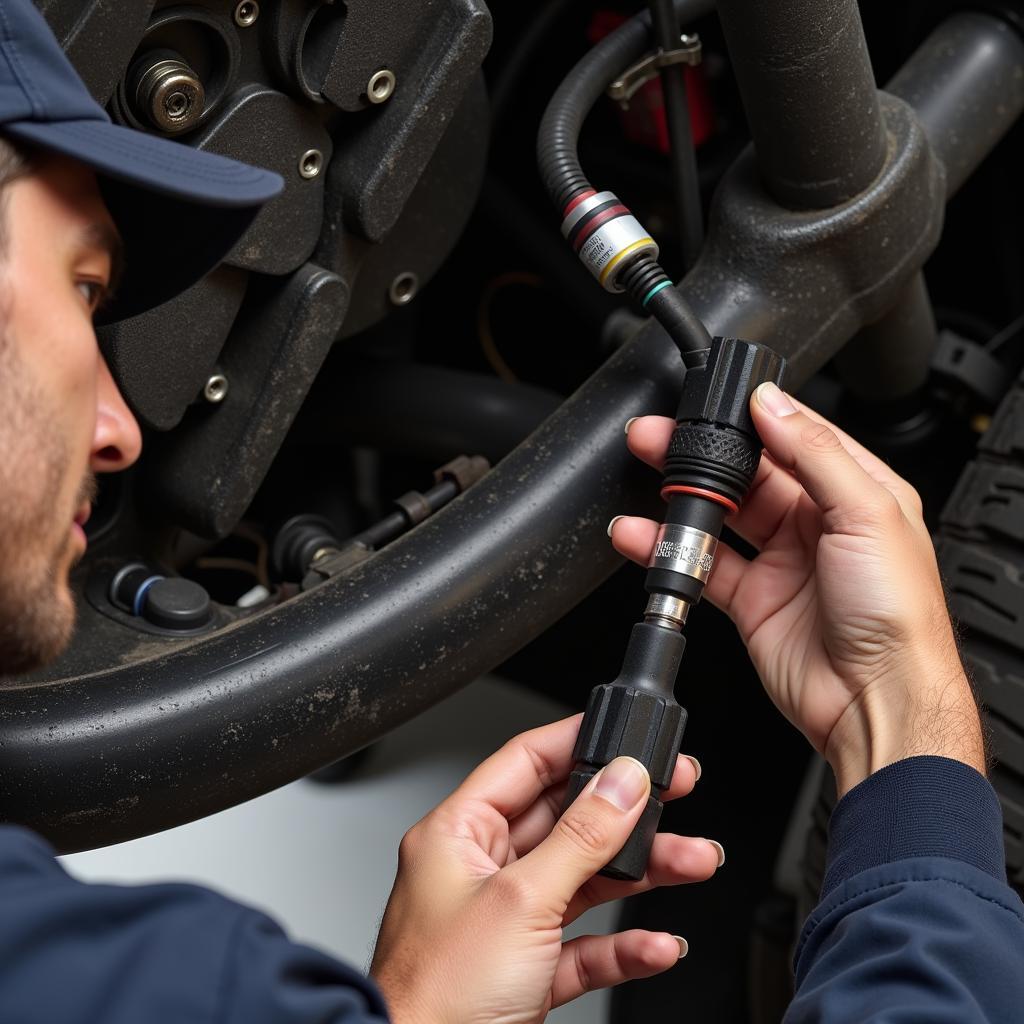The OBD2 code P0139, often appearing on Dodge vehicles, indicates a problem with the oxygen sensor circuit’s response time. Specifically, it points to the downstream oxygen sensor (Sensor 2) on Bank 1, which monitors the exhaust after the catalytic converter. This sensor plays a vital role in helping your Dodge’s engine control unit (ECU) optimize fuel-air mixture for optimal performance and emissions control.
Understanding the OBD2 Code P0139
When your Dodge’s ECU detects a sluggish response from the downstream oxygen sensor (Bank 1, Sensor 2), it logs the P0139 code. This slow response time hinders the ECU’s ability to make precise adjustments to the fuel-air mixture. Instead of receiving rapid voltage fluctuations signaling changes in oxygen levels, the ECU receives a delayed or erratic signal, making it difficult to determine if the catalytic converter is functioning correctly.
What Causes OBD2 Code P0139 in Dodge Vehicles?
Several factors can contribute to a P0139 code in your Dodge:
- Faulty Oxygen Sensor: A common culprit is a worn-out or malfunctioning oxygen sensor. Over time, sensors can degrade, leading to inaccurate readings and slow response times.
- Exhaust Leaks: Leaks in the exhaust system, particularly before the downstream oxygen sensor, can introduce fresh air and disrupt the sensor’s ability to accurately measure oxygen content.
- Wiring Issues: Damaged, corroded, or loose wiring connections within the oxygen sensor circuit can disrupt the signal transmission between the sensor and the ECU.
- Vacuum Leaks: Leaks in the engine’s vacuum system can upset the fuel-air mixture, indirectly affecting the readings from the downstream oxygen sensor.
- Faulty Catalytic Converter: While less common, a malfunctioning catalytic converter can also trigger a P0139 code by altering the exhaust gas composition and affecting the downstream sensor’s readings.
Symptoms of a P0139 Code in Your Dodge
While the check engine light illuminating on your dashboard is a primary indicator, you might experience these additional symptoms:
- Decreased Fuel Economy: A sluggish oxygen sensor can disrupt the fuel-air mixture, leading to inefficient fuel consumption and reduced mileage.
- Rough Engine Idle: An imbalanced fuel-air mixture can cause your engine to idle roughly or stumble.
- Failed Emissions Test: A malfunctioning downstream oxygen sensor can lead to increased emissions, potentially causing your vehicle to fail an emissions test.
Diagnosing and Fixing the P0139 Code
Accurately diagnosing the root cause of the P0139 code is crucial for effective repair. Here’s a step-by-step approach:
-
Read the Code: Begin by using an OBD2 scanner to confirm the P0139 code and check for any other stored codes that might provide additional clues.
-
Inspect the Oxygen Sensor: Visually inspect the downstream oxygen sensor (Bank 1, Sensor 2) and its wiring harness for any signs of damage, corrosion, or loose connections.
-
Check for Exhaust Leaks: Examine the exhaust system, focusing on the area around the downstream oxygen sensor, for any leaks.
-
Test the Sensor Voltage: Use a multimeter to test the voltage signal from the oxygen sensor. A healthy sensor should fluctuate between 0.1 volts and 0.9 volts.
-
Inspect Vacuum Lines: Inspect the vacuum lines connected to the intake manifold and other engine components for any cracks, loose connections, or signs of deterioration.
 Mechanic Inspecting Oxygen Sensor Wiring
Mechanic Inspecting Oxygen Sensor Wiring
When to Seek Professional Help
If you’re uncomfortable performing these diagnostic steps or if the problem persists after addressing potential issues, it’s best to consult a qualified mechanic specializing in Dodge vehicles. They have the expertise, tools, and experience to accurately pinpoint and repair the underlying cause of the P0139 code.
Dodge P0139 Code: FAQs
1. Can I still drive my Dodge with a P0139 code?
While you might be able to drive for a short period, it’s not recommended. Driving with a P0139 code can lead to decreased fuel economy, potential damage to other engine components, and even result in a failed emissions test.
2. How much does it cost to replace an oxygen sensor in a Dodge?
The cost of oxygen sensor replacement varies depending on the specific Dodge model, labor costs, and whether you choose OEM or aftermarket parts.
3. How often should oxygen sensors be replaced in a Dodge?
Oxygen sensors typically have a lifespan of 60,000 to 90,000 miles.
Need More Help with Your Dodge OBD2 Codes?
For personalized assistance with your Dodge’s P0139 code or any other car diagnostic needs, don’t hesitate to reach out to our expert team. Contact us via WhatsApp at +1(641)206-8880 or email us at [email protected]. We’re available 24/7 to provide support and guidance.
